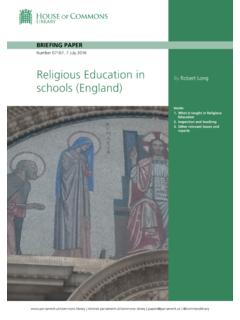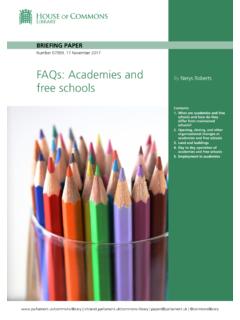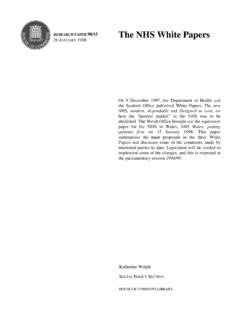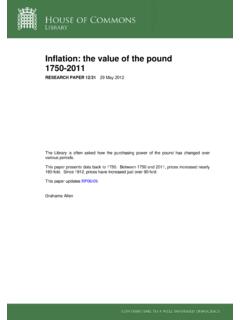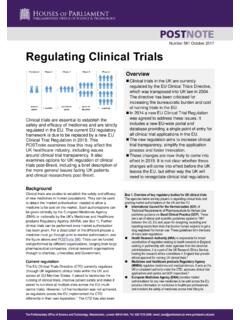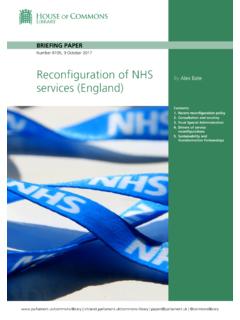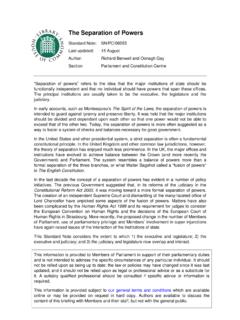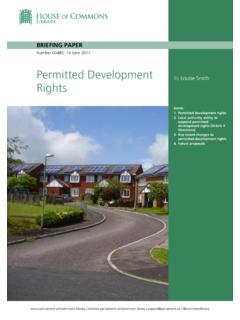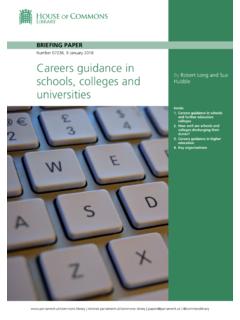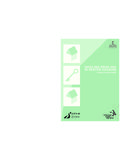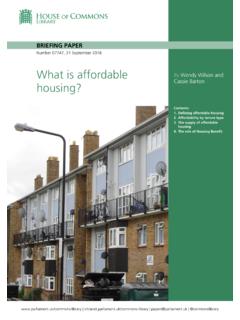Transcription of Homes (Fitness for Human Habitation) Bill 2017-19
1 | | | @commonslibrary BRIEFING PAPER Number CBP08185, 1 August 2018 Homes (Fitness for Human Habitation) Bill 2017-19 By Wendy Wilson Contents: 1. Property standards: background 2. What is the Bill seeking to do? 3. Reaction to the Bill 4. The Bill s progress through Parliament 2 Homes (Fitness for Human Habitation) Bill 2017-19 Contents Summary 3 1. Property standards: background 6 Property standards the evidence 6 Measuring property standards 7 Fitness for Human habitation 7 The Housing, Health and Safety Rating System (HHSRS) 8 The decent home standard 9 Housing repairs and standards an overview of the legal framework 9 Building Regulations and fire safety 9 Defective premises 10 Landlords repairing duties 10 Houses in multiple occupation (HMOs) 11 Specific requirements in rented dwellings 12 Statutory nuisance 14 Blocks of leasehold flats 14 A piecemeal and out-of-date framework?
2 14 No requirement of fitness for Human habitation 14 The limits of section 11 duties 16 The risk of retaliatory eviction 16 The availability of legal aid 17 HHSRS: complexity and enforcement 18 Statutory nuisance an anachronism? 20 Comparisons with Wales, Scotland and Northern Ireland 20 Scotland 20 Wales 23 Northern Ireland 23 2. What is the Bill seeking to do? 26 Amending the Landlord and Tenant Act 1985 (clause 1 as originally introduced) 26 Commencement (clause 2 as originally introduced) 29 3. Reaction to the Bill 30 4. The Bill s progress through Parliament 34 Amendments in Public Bill Committee 20 June 2018 34 Contributing Authors: Hannah Cromarty - Social Policy Section Cover page image copyright Wendy Wilson 3 Commons Library Briefing, 1 August 2018 Summary The purpose of the Bill Karen Buck s Homes (Fitness for Human Habitation) Bill 2017-19 is seeking to amend relevant sections of the Landlord and Tenant Act 1985 by extending its obligations to cover almost all landlords and to modernise the fitness for habitation test.
3 As a result of rent limits which have remained unchanged since the 1950s, the current requirement for fitness in section 8 of the 1985 Act has ceased, for the most part, to have effect. Where a landlord fails to let and maintain a property that is fit for Human habitation, the Bill would give tenants a right to take action in the courts. The Bill has cross-party support. The Bill extends to England and Wales but will only apply to tenancies in England. The Welsh Government has already included similar provisions in relation to housing fitness in the Renting Homes (Wales) Act 2016. The Bill had its First Reading in the House of Commons on 19 July 2017 and its Second Reading on 19 January 2018. The Public Bill Committee met on 20 June 2018. The Committee agreed to 16 amendments without division. The Bill s Report stage in the House of Commons is scheduled to take place on 26 October 2018. This Commons Library paper provides background to the Bill and explains its provisions and amendments made at Committee stage.
4 Housing standards in England There have been longstanding concerns about property standards in the private rented sector (PRS). The PRS houses more households in England than the social rented sector but has some of the poorest property standards. The 2016/17 English Housing Survey (EHS) found that the PRS had the highest proportion of Homes with at least one indicator of poor housing (38%). The EHS 2016/17 records that 27% of PRS Homes failed the decent home standard in 2016. The comparative figures for the owner-occupied and social housing sectors were 20% and 13% respectively. Whilst the proportion of non-decent Homes in the PRS has fallen from 47% in 2006 to 27% in 2016, the number of dwellings in this tenure failing the Standard has remained fairly constant; million in 2006 and million in 2016. More broadly, the EHS 2016/17 records that, across all tenures, the proportion of non-decent Homes declined steadily from 2006, with year-on-year improvements until 2014, since when the proportion has remained stable.
5 The Grenfell Tower fire has focused attention on housing standards in the social rented stock, and also in privately owned blocks of flats. Why is the Bill needed? There are statutory obligations on most landlords to keep in repair the structure and exterior of their properties, and to repair installations for the supply of water, heating and sanitation. However, provisions requiring landlords to ensure that their properties are fit for Human habitation have ceased to have effect because of annual rent limits ( 52 or less, and 80 or less in London). The Housing, Health and Safety Rating System (HHSRS) was introduced by the Housing Act 2004. The HHSRS is a risk-based approach used to assess risks to health and safety in the home by looking at the likelihood of particular faults or deficiencies, which could cause injury, ill health or impact on the wellbeing of those living in the dwelling. While this 4 Homes (Fitness for Human Habitation) Bill 2017-19 risk-based approach is felt to offer benefits over a pass/fail standard of housing fitness, the HHSRS is widely viewed as complex and to suffer from inconsistent application and enforcement by local authorities.
6 The operating guidance has not been updated since 2006. Reports published by several bodies, including the Communities and Local Government Select Committee in 2013, and Shelter in 2014, have recommended a review of the HHSRS. Tenants face particular issues when seeking to improve housing conditions. Local authorities cannot take enforcement action against themselves this can leave council tenants at a relative disadvantage if their landlord does not respond to the presence of health and safety hazards in their Homes . Landlords of private tenants may respond to requests for repairs by beginning eviction procedures, this is referred to as retaliatory eviction. Commentators also highlight the lack of legal aid for disrepair cases as a barrier to tenants seeking to improve their housing conditions. A joint report commissioned by Shelter from the universities of Bristol and Kent (2017) concluded: The law relating to health and safety in people s Homes is piecemeal, out-dated, complex, dependent on tenure, and patchily enforced.
7 It makes obscure distinctions, which have little relationship with everyday experiences of poor conditions. Recent attempts to amend the law Karen Buck presented the Homes (Fitness for Human Habitation) Bill on 24 June 2015. The purpose of the Bill was "to amend the Landlord and Tenant Act 1985 to require that residential rented accommodation is provided and maintained in a state of fitness for Human habitation; and for connected purposes. The Second Reading debate on the Bill took place on 16 October 2015. The debate was adjourned and the Bill failed to make progress. During the Committee Stage of the Housing and Planning Bill 2015-16, Shadow Housing Minister, Teresa Pearce, attempted to amend the Bill to introduce Karen Buck s fitness for Human habitation proposals. In response, the then Housing Minister, Brandon Lewis, said that the Bill s proposals on rogue landlords were a better way to improve standards without imposing unnecessary regulation on landlords.
8 The Minister argued that the HHSRS was in place to keep properties in a decent state of repair, and that it was up to local authorities to enforce this properly. The amendment was withdrawn but further attempts to amend the Bill in respect of fitness for Human habitation were made on Report in the Commons and during the Committee stages in the House of Lords. On both occasions the amendment was defeated. Reaction to the Bill The Shelter briefing on the Bill called on the Government to: ..adopt this Bill as part of a cross-party, national, response to the Grenfell tragedy so that future tenants are not ignored and their safety put at risk. Both the Residential Landlords Association (RLA) and National Landlords Association (NLA) have expressed support for the Bill. Policy Director at the RLA, David Smith, said: Tenants have a right to expect that Homes are fit for habitation, and the vast majority of good landlords already provide this.
9 This Bill therefore reinforces what landlords should already be doing. The joint report by the universities of Bristol and Kent, Closing the Gaps: Health and Safety at Home (2017) also expressed support for the Bill s provisions: 5 Commons Library Briefing, 1 August 2018 This Bill addresses and provides redress for the gaps which currently exist in the private law of landlord and tenant regarding the state and condition of the property; the restrictions on a landlord s repairing obligations; and updating the criteria for determining fitness. 6 Homes (Fitness for Human Habitation) Bill 2017-19 1. Property standards: background Housing policy is devolved. The following sections outline the position in England, section explains the equivalent position in Scotland, Wales and Northern Ireland. Property standards the evidence The 2016/17 English Housing Survey (EHS) found that 38% of private renters lived in poor housing (defined as a home that has serious damp or mould, a Category 1 HHSRS hazard, is non-decent, or has substantial disrepair), compared to 24% of owner occupiers and 22% of social The EHS 2016/17 records that 27% of PRS Homes failed the decent home standard2 in 2016.
10 The comparative figures for the owner-occupied and social housing sectors were 20% and 13% The PRS has always performed less well than other tenures against this measure. The level of non-decent Homes in the PRS reduced between 2006 and 2016 from 47% to 27%. However, although the proportion of non-decent private rented Homes has fallen over time, largely due to the increase in the size of the sector, the number of dwellings in this tenure failing the Standard has remained fairly constant; million in 2006 and million in Poor standards of maintenance and repair of some properties in the PRS are often cited as a downside of this tenure. A 2013 report on the PRS by the Communities and Local Government (CLG) Select Committee said: Although we received some evidence suggesting that standards in the private rented sector had risen in recent years, we heard concerns from a number of people about the physical standards of property in some parts of the sector, and the way in which some landlords carried out their management The Residential Landlords Association's (RLA) evidence to the Committee's inquiry into the PRS agreed that substandard accommodation was unacceptable but highlighted an 85% satisfaction rate with landlords amongst private tenants compared to 81% amongst social The EHS 2016/17 records an 84% satisfaction rate amongst private 1 English Housing Survey 2016.

